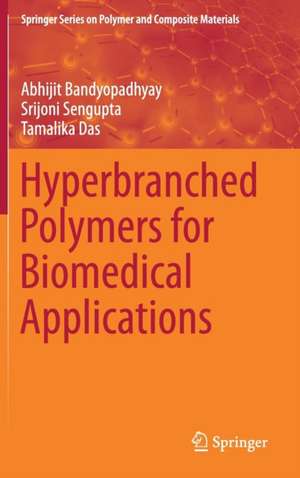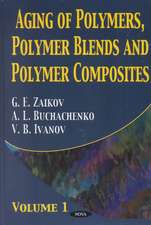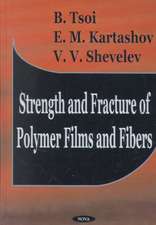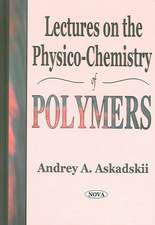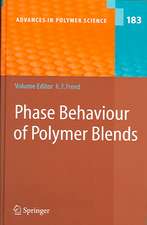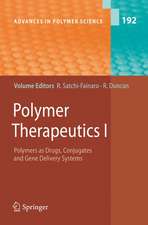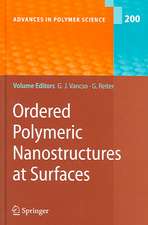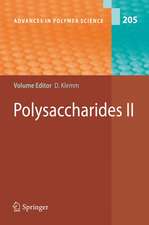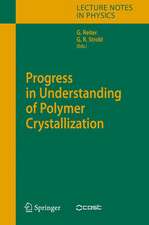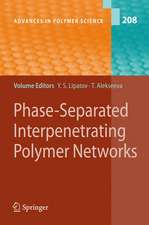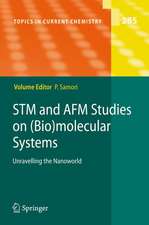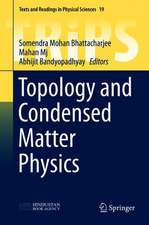Hyperbranched Polymers for Biomedical Applications: Springer Series on Polymer and Composite Materials
Autor Abhijit Bandyopadhyay, Srijoni Sengupta, Tamalika Dasen Limba Engleză Hardback – 27 sep 2017
This book presents a comprehensive study on a new class of branched polymers, known as hyperbranched polymers (HBPs). It discusses in detail the synthesis strategies for these particular classes of polymers as well as biocompatible and biodegradable HBPs, which are of increasing interest to polymer technologists due to their immense potential in biomedical applications. The book also describes the one-pot synthesis technique for HBPs, which is feasible for large-scale production, as well as HBPs’ structure-property relationship, which makes them superior to their linear counterparts.
The alterable functional groups present at the terminal ends of the branches make HBPs promising candidates in the biomedical domain, and the book specifically elaborates on the suitable characteristic properties of each of the potential biological HBPs’ applications. As such, the book offers a valuable reference guide for all scientists and technologists who are interested
in using these newly developed techniques to achieve faster and better treatments.| Toate formatele și edițiile | Preț | Express |
|---|---|---|
| Paperback (1) | 382.18 lei 43-57 zile | |
| Springer Nature Singapore – 23 dec 2018 | 382.18 lei 43-57 zile | |
| Hardback (1) | 389.49 lei 43-57 zile | |
| Springer Nature Singapore – 27 sep 2017 | 389.49 lei 43-57 zile |
Din seria Springer Series on Polymer and Composite Materials
- 18%
 Preț: 1106.00 lei
Preț: 1106.00 lei - 18%
 Preț: 1228.47 lei
Preț: 1228.47 lei - 18%
 Preț: 1108.51 lei
Preț: 1108.51 lei - 15%
 Preț: 653.00 lei
Preț: 653.00 lei - 15%
 Preț: 641.85 lei
Preț: 641.85 lei - 18%
 Preț: 1105.50 lei
Preț: 1105.50 lei - 15%
 Preț: 641.53 lei
Preț: 641.53 lei - 18%
 Preț: 1230.53 lei
Preț: 1230.53 lei - 15%
 Preț: 644.18 lei
Preț: 644.18 lei - 18%
 Preț: 995.53 lei
Preț: 995.53 lei - 18%
 Preț: 956.18 lei
Preț: 956.18 lei - 18%
 Preț: 952.89 lei
Preț: 952.89 lei - 18%
 Preț: 953.82 lei
Preț: 953.82 lei - 15%
 Preț: 638.72 lei
Preț: 638.72 lei - 18%
 Preț: 1013.50 lei
Preț: 1013.50 lei - 15%
 Preț: 643.84 lei
Preț: 643.84 lei - 15%
 Preț: 651.67 lei
Preț: 651.67 lei - 15%
 Preț: 660.18 lei
Preț: 660.18 lei - 18%
 Preț: 1671.39 lei
Preț: 1671.39 lei - 15%
 Preț: 644.49 lei
Preț: 644.49 lei - 15%
 Preț: 635.80 lei
Preț: 635.80 lei - 18%
 Preț: 1127.78 lei
Preț: 1127.78 lei - 18%
 Preț: 887.51 lei
Preț: 887.51 lei - 18%
 Preț: 1118.13 lei
Preț: 1118.13 lei - 18%
 Preț: 900.63 lei
Preț: 900.63 lei - 18%
 Preț: 1121.16 lei
Preț: 1121.16 lei - 15%
 Preț: 651.84 lei
Preț: 651.84 lei - 18%
 Preț: 953.35 lei
Preț: 953.35 lei - 15%
 Preț: 651.34 lei
Preț: 651.34 lei
Preț: 389.49 lei
Nou
Puncte Express: 584
Preț estimativ în valută:
74.55€ • 81.01$ • 62.66£
74.55€ • 81.01$ • 62.66£
Carte tipărită la comandă
Livrare economică 21 aprilie-05 mai
Preluare comenzi: 021 569.72.76
Specificații
ISBN-13: 9789811065132
ISBN-10: 9811065136
Pagini: 178
Ilustrații: XI, 178 p. 109 illus.
Dimensiuni: 155 x 235 mm
Greutate: 0.45 kg
Ediția:1st ed. 2018
Editura: Springer Nature Singapore
Colecția Springer
Seria Springer Series on Polymer and Composite Materials
Locul publicării:Singapore, Singapore
ISBN-10: 9811065136
Pagini: 178
Ilustrații: XI, 178 p. 109 illus.
Dimensiuni: 155 x 235 mm
Greutate: 0.45 kg
Ediția:1st ed. 2018
Editura: Springer Nature Singapore
Colecția Springer
Seria Springer Series on Polymer and Composite Materials
Locul publicării:Singapore, Singapore
Cuprins
Introduction.- Synthesis of hyperbranched polymers: Step growth method.- Synthesis of hyperbranched polymers: Mixed methods.- Structure-Property relationship of Hyperbranched polymers.- Latest biomedical applications of hyperbranched polymers: Part 1: As delivery vehicle.- Part II: In bioimaging.- Part III: For tissue engineering.
Notă biografică
Dr. Abhijit Bandyopadhyay holds an M.Tech and Ph.D. in Polymer Science and Technology and is currently Head of the Department of Polymer Science and Technology, University of Calcutta. He is also a Technical Director at the South Asian Rubber & Polymers Park (SARPOL) in West Bengal, India. He is a former Assistant Professor of the Rubber Technology Centre at the Indian Institute of Technology Kharagpur (IIT Kharagpur), India. He has more than 10 years of teaching and research experience and has published more than 75 research papers in high-impact international journals, four book chapters, one book and holds one Indian patent. He has received numerous awards, including the Young Scientist Award from the Materials Research Society of India, Calcutta Chapter; the Young Scientist Award from the Department of Science & Technology, Government of India; and the Career Award for Young Teachers from the All India Council for Technical Education, Government of India. He is a life member of the Society for Polymer Science, India, Associate Life Member of the Indian Institute of Chemical Engineers and a Fellow of the International Congress of Environmental Research. He also serves on the Editorial Boards of various international journals.
Ms. Srijoni Sengupta is a research scholar at the Department of Polymer Science and Technology, University of Calcutta, India. She received her initial degree in Chemistry (Hons) from Lady Brabourne College (Kolkata) in 2010 before completing her B.Tech (2013) and M.Tech (2015) in Polymer Science and Technology at the University of Calcutta. She is currently pursuing her Ph.D. on the “Synthesis, Study of Structure-Property Relationships and Potential Applications of Hyperbranched Polymers via Polycondensation Technique”. She has published a number of papers in research journals and is presently engaged in an INSPIRE Fellowship from the Department of Science and Technology, Government of India.
Ms. Tamalika Dasgraduated in Chemistry (Hons) from Scottish Church College (Kolkata) in 2008. She subsequently completed her B.Tech (2011) and M.Tech (2013) degrees at the Department of Polymer Science and Technology at the University of Calcutta. She was awarded the gold medal from the University of Calcutta twice (during both her B.Tech and M.Tech). She did her M.Tech project at the Indian Association for the Cultivation of Science (Kolkata). Currently, she is pursuing her doctoral research at the Department of Polymer Science and Technology at the University of Calcutta. Her main area of interest is hyperbranched polymers. She has published one paper in a high-impact international journal and is currently engaged in an INSPIRE Fellowship from the Department of Science and Technology, Government of India.
Textul de pe ultima copertă
This book presents a comprehensive study on a new class of branched polymers, known as hyperbranched polymers (HBPs). It discusses in detail the synthesis strategies for these particular classes of polymers as well as biocompatible and biodegradable HBPs, which are of increasing interest to polymer technologists due to their immense potential in biomedical applications. The book also describes the one-pot synthesis technique for HBPs, which is feasible for large-scale production, as well as HBPs’ structure-property relationship, which makes them superior to their linear counterparts.
The alterable functional groups present at the terminal ends of the branches make HBPs promising candidates in the biomedical domain, and the book specifically elaborates on the suitable characteristic properties of each of the potential biological HBPs’ applications. As such, the book offers a valuable reference guide for all scientists and technologists who are interested
in using these newly developed techniques to achieve faster and better treatments.Caracteristici
Presents a detailed study of a new class of branched polymers—hyperbranched polymers Discusses biological applications of hyperbranched polymers Elaborates the structure–property relationship of hyperbranched polymers Includes supplementary material: sn.pub/extras
